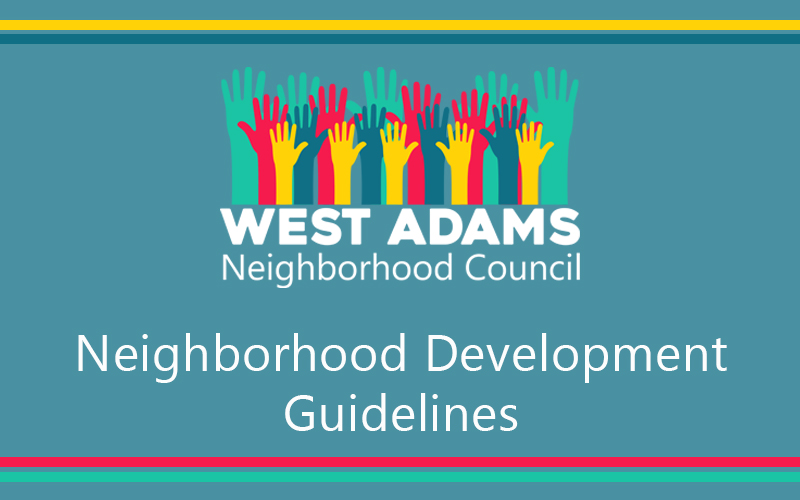The West Adams Neighborhood Council (“West Adams NC”) strongly believes all new development should reflect the priorities of this community. Our priorities include equitable housing / affordability, pedestrian safety, multi-modal transportation, environmental sustainability and respectful construction. We developed the following guidelines to reflect our priorities. It is not our intention to design projects, but it is our intention to ensure new development respects our priorities. We believe all new developments should conform to these guidelines regardless of whether projects are ministerial or require discretionary approval.
When presenting to the Land Use Committee, we will use these Guidelines to direct our conversation, but that conversation may not be limited to just these Guidelines. Presenters should be prepared to respond to each item listed below. If your development has special needs that make any of our requests difficult or impossible, please come to a Land Use meeting early in your design process so we can work together to find solutions.
PEDESTRIAN ORIENTED DESIGN
1. Ground Floor Uses. No development shall have ground floor parking facing the primary street frontage at the property line. Ground floor street-facing uses must be active including retail, restaurant, commercial office, leasing office, community space, lobby, dwelling unit, landscaping, etc.
2. Vehicle Access. To maximize pedestrian safety, both ingress and egress shall be provided via an alley or a side street unless no alley or side street is available. When the Project Site is located on a corner lot, the driveway shall be located as far from an intersection as possible to avoid vehicular conflicts.
Additional measures to enhance pedestrian safety at a driveway include mounting convex mirrors inside the drive aisle to increase visibility of oncoming pedestrians and continuous sidewalk paving across the driveway.
3. Lighting and Enhanced Security. Pedestrian scale lighting shall be provided at the street level to enhance visibility on the sidewalk. Multi-story projects should include a Blue Emergency light / call box near the entrance and in the parking area.
4. Streetscape. All new developments shall provide an enhanced street landscaping plan that includes, at a minimum, parkway trees. Young trees, necessarily uprooted during construction, should be replaced on a one on one or greater basis. All ground level landscaping and public area landscaping in the project should be maintained by the property manager once the project is complete.
INCENTIVES FOR ALTERNATIVE MODES OF TRANSPORTATION
5. Transit Passes. All new developments shall purchase pre-paid transit passes for at least 6 months for all new tenants.
6. Bus Shelters. If a proposed development is located adjacent to an existing bus stop without a bus shelter, the developer shall design an area in compliance with the Bureau of Street Services requirements for bus shelters. All existing bus shelters shall be preserved. If construction activities will impact an existing bus shelter, the developer shall present a temporary plan for bus riders.
7. EV Parking. 30% or more of parking spaces should be equipped with electric vehicle charging stations of 40amps each or higher.
8. Car Sharing. To minimize personal vehicle ownership, developers should explore the feasibility of on-site car sharing such as zip car or curbside car sharing
9. Multi-modal sharing parking. Provide short-term visitor bicycle or e-scooter or fad of the era parking in front of the building.
HOUSING AFFORDABILITY AND TENANTS RIGHTS
10. Existing Tenants. If existing tenants are on-site, provide Ellis Act documentation to the Land Use Committee or timeline for proposed evictions.
11. Housing Replacement. If the Project Site is improved with dwelling units, Projects must comply with state law to replace the existing affordable housing with new affordable units. Our expectation is that any low income housing units replaced by the development be replaced by an equal or greater number of very low or extremely low housing units. This measurement of units is both in overall quantity of units and in bedrooms. We encourage developers to consider making the city mandated number of income regulated units very low income and to then dedicate an equal number of units to no more than moderate income as defined by HUD and the City.
12. Early Notification to Neighborhood Council. If the Project consists of restricted affordable units, the Developer must notify the neighborhood council 90 days prior to the units coming onto the market with information regarding how to apply so eligible local residents have an opportunity to apply for the restricted affordable units.
- Displaced area residents should be given first opportunity to apply for low / lower cost rental units.
SUSTAINABILITY AND GREENER LIVING
13. Native Landscaping. Native landscaping is strongly supported and recommended (not just drought tolerant or “California friendly” plants). A list of easy to use, common sense options for your landscaping needs can be obtained through contact with the City of LA Urban Forestry Division.
14. Existing Street Trees. Preserving existing mature trees is a priority even when they are non-native. These trees must be protected/fenced at the start of construction. Please consult City of LA Urban Forestry Division.
15. Green Buildings. The purpose of the California Green Building Code (CALGreen) is to improve public health, safety, and general welfare through enhanced design and construction of buildings, using concepts which reduce negative impact, and promote principles which have a positive environmental impact and encourage sustainable construction practices.
The Los Angeles Green Building Code (LAGBC) is based on the 2013 California Green Building Standards Code that was developed and mandated by the State to attain consistency among the various jurisdictions within the State, reduce the building’s energy and water use, reduce waste, and reduce the carbon footprint.
Please provide information regarding how your proposed development will take steps conserve energy or improve water efficiency.
COMMUNITY AMENITIES
16. Arts Development Fees. For projects with commercial, hotel or warehouse/industrial uses, Developer shall present a plan to do a Developer-Led Project in lieu of the “paid-in fee” option to guarantee the funds get utilized in the West Adams NC area.
CONSTRUCTION
17. Security. Developer shall secure the property before and after demolition with, at a minimum, fencing secured in ground. Security cameras and on-site security officers are encouraged.
18. Crews and Subcontractors. The developer shall make strong, verifiable efforts to hire 20% or their workforce from the West Adams NC area. The developer will also make a strong effort to include minority owned, women-owned enterprise, or disadvantaged business enterprises in participation in the project.
19. Neighbors. The developer will take utmost effort to not impinge on the property rights of the project neighbors. Dust and noise abatement protocols shall be required by the Developer. Retaining walls, contiguous walls, overhanging access all need to be brought before the Land Use Committee and the property owners adjacent to the project must be informed of planned efforts to limit construction related issues.
20. Graffiti and Refuse Removal. Developer shall also ensure prompt removal of graffiti or large refuse items and maintain the site before and after beginning of construction. Construction refuse is not allowed outside the site construction fencing. Landscaping outside the construction fencing shall be maintained by the developer during construction to maintain a safe and visually pleasing neighborhood.
21. Pest Control. All buildings being demolished shall tent and have a plan developed for pest control treatment to deter pests from invading adjacent properties prior to demolition. This applies to Project Sites with and without existing buildings.
22. Construction Parking. Developer shall coordinate off-site parking for construction workers prior to completion of the Project’s on-site parking garage so that construction vehicles do not block on-street parking or alley access from residents of adjacent buildings. Construction workers are not to be allowed to park on residential streets except for 30 minutes to load tools and small amounts of construction supplies. Large construction vehicles required for deliveries in residential areas shall be staged on commercial streets and brought onsite briefly, to offload. Construction materials may not be stored outside the construction fencing in residential areas.
23. Flaggers. Provide flaggers for traffic safety during construction activities that requires large construction vehicles to be on the street.
24. Hauling. If exporting earth is a part of construction, developer must limit hauling until after 9 AM on residential streets. If Project Site is located on a residential street, haul routes should use shortest route from Project Site to major commercial boulevard to access freeway. Haul trucks should stack on the commercial boulevard instead of on residential streets.
25. Sidewalks. On commercial streets, developer shall make best efforts to keep sidewalks open to pedestrians during construction at all times, if necessary, with a canopy. If sidewalks must be temporarily closed, developer shall place redirecting signs for pedestrians at the nearest signalized intersections. On residential streets, developers shall keep sidewalks open outside of construction hours.
26. Alley Resurfacing. Developer shall resurface that portion of the alley that is immediately adjacent to the Project’s property lines. Additionally, the Applicant will seek consensus from adjacent property owners to resurface the entire alleyway.
27. Communication with the immediate adjacent community. Developer shall present a communication program to advise the neighborhood council, surrounding neighbors and other interested parties of upcoming construction milestones including demolition, excavation, and construction. For example, post a visible sign on-site with a rendering and proposed construction dates, lawn signs, and perhaps create a website showing milestone completion.
To view Land Use Committee, go to Standing and Ad Hoc Committees, then select “Land Use Committee” tab.





